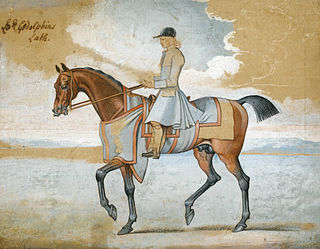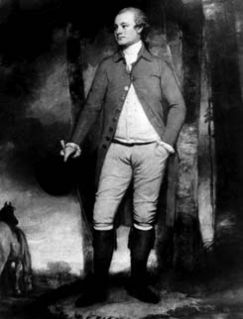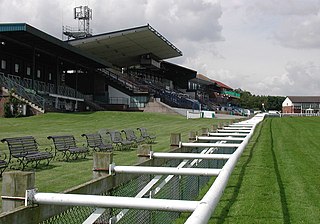Young Eclipse was a Thoroughbred racehorse that won the 1781 Epsom Derby. He raced until he was six years old, winning seven races and retiring to stud in 1785. He was not a successful sire.
Assassin was a Thoroughbred racehorse that won the 1782 Epsom Derby. His breeder, Lord Egremont, won the Derby for the first time with Assassin. Assassin raced until he was a five-year-old and was retired to Egremont's stud in Petworth. He was not a successful sire.

Snap was a Thoroughbred racehorse who won all four of his races. After retiring from racing he became a successful stallion. He was Champion sire four times and his progeny included the undefeated Goldfinder.
Bartlett's Childers was an important Thoroughbred sire in the 18th century.

Goldfinder (1764–1789) was an undefeated Thoroughbred racehorse. His wins included two Newmarket Challenge Cup and Whips. After retiring from racing he became a successful sire.

Bay Bolton or Brown Lusty (1705–1736) was a British Thoroughbred racehorse who won Queen Anne's Gold Cup as a five-year-old in 1710. After retiring from racing he became a successful sire for the Charles Paulet, 2nd Duke of Bolton, and his son Charles Powlett, 3rd Duke of Bolton, was Champion sire seven times.
King Fergus (1775–1801) was a British Thoroughbred racehorse. He won several races, but achieved greater success as a sire. He was British Champion sire in 1797 and his progeny included St Leger Stakes winner Hambletonian, who was only defeated once in his 19 race career.
The 1200 Guineas Stakes was a flat horse race in Great Britain open to thoroughbreds aged five years. It was run at Newmarket and was one of the most important races of the second half of the 18th century.
Bald Galloway was a leading Thoroughbred sire in the 18th century. He was foaled in about 1705 and was bred by Captain Rider. He was sired by St. Victor's Barb and his dam was Grey Whynot, a daughter of Whynot. Grey Whynot's dam was a Royal mare. Bald Galloway was leading Leading sire in Great Britain and Ireland in 1725. His best racing son was Buckhunter, who won Queen Anne's Gold Cup at York in 1719 and several King's Plates. He also sired Bald Ovington, Cartouch, Daffodil, Dart, Foxhunter, Grey Ovington, Grey Robinson, Roxana, Silverlocks and Snake. Roxana was the dam of Lath and multiple champion sire Cade. Grey Robinson was the dam of the undefeated Regulus. He was a chestnut horse and stood at the Oak-Tree, Leeming-lane in Yorkshire.
Blank (1740–1770) was a British Thoroughbred racehorse and sire. He only won one race, but became a very successful sire and was British Champion sire in 1762, 1764 and 1770.
The 1400 Guineas Stakes was a flat horse race in Great Britain open to thoroughbreds aged four years. It was run at Newmarket and was one of the most important races of the second half of the 18th century.
Crab also known as Old Crab and Mr. Panton's Crab was a British Thoroughbred racehorse. After retiring from racing he became a successful stallion and was British Champion sire in 1748, 1749 and 1750. He was owned by the 1st Earl of Portmore until purchased by Mr. Cotton and then Thomas Panton.
Spilletta was a British Thoroughbred racehorse. She only raced once and is best known for being the dam of the undefeated Eclipse.

Sweetbriar was a British Thoroughbred racehorse. He won all eight of the races he contested, including a match race against Craven Stakes winner Firetail. He later became a successful stallion, with his progeny including Epsom Derby winner Assassin.

Alipes was a British Thoroughbred racehorse. She was undefeated in her eight career starts, with her wins including the Great Subscription Purse for four-year-olds in 1761. She was owned by Sir B. Graham and later Richard Grosvenor, 1st Baron Grosvenor.
Snip was a British Thoroughbred racehorse. He only won one race, but later became a successful sire. His son Snap was undefeated in his four races and became a multiple-time Champion sire. Snip was bred and owned by William Cavendish, 3rd Duke of Devonshire.
Hollandoise, or alternatively Hollandaise, (1775–1782) was a grey British Thoroughbred mare that won the 1778 St. Leger Stakes, the first horse to win the event under its formal title. Raced sporadically from 1778 to 1782, Hollandoise won eight races in 14 starts. She died suddenly shortly after her last race in 1782 before producing any offspring.

Lath was a British Thoroughbred racehorse. He won at least four races, including a 1000 guinea sweepstakes at Newmarket and a match race against Squirt. After retiring from racing he became a stallion and produced a number of high class runners and also sired the grand-dam of St.Leger winner Hollandoise.
Squirrel (1754–1780) was a British Thoroughbred racehorse. He won seven of his nine races, including the 1400 Guineas Stakes and match races against Dapper and Jason. He was also a successful stallion, siring Craven Stakes winner Firetail. However he was more well known for producing broodmares, siring the dams of seven Classic winners including Derby winner Noble, along with the dam of champion sire Trumpator. Squirrel was owned by Jenison Shafto.

Bridget (1776–1798) was a British Thoroughbred racehorse who won the inaugural running of the Oaks Stakes in 1779. She was bred and owned by Edward Smith-Stanley, 12th Earl of Derby, for whom she produced five foals as a broodmare.













